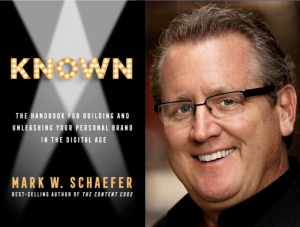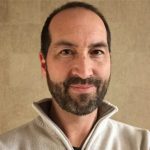Article in Brief: Whether you are an entrepreneur, company leader or independent creative, your ability to scale depends on you becoming known, liked and trusted. This article presents Mark Schaefer’s practical process for building your personal brand.
by Keith Reynold Jennings
This past April, I heard a conversation that changed things for me.
That conversation, between John Jantsch and Mark Schaefer, was about how people like you and me can successfully build a personal brand that breaks through in today’s noisy world. Is it even possible?
As I listened, what surprised me most was this: the process Mark presented on becoming known was memorable, actionable and sustainable. It was very different from the glib attempts I’ve read and heard on personal branding over the years.
It was clear to me, after hearing Mark, that he was someone grounded in the real world. But highly strategic and intelligent.
 That Wednesday afternoon, I bought Mark’s book, Known: The Handbook for Building and Unleashing Your Personal Brand in the Age of Digital. It arrived on Saturday. And I read it in one sitting.
That Wednesday afternoon, I bought Mark’s book, Known: The Handbook for Building and Unleashing Your Personal Brand in the Age of Digital. It arrived on Saturday. And I read it in one sitting.
Then I read it again, cover to cover, the next day. And I started deliberately working through the exercises in the book, searching for the thematic threads in my life and work.
My motive for building a personal brand is multifaceted. It can bring lift to the company I’m privileged to serve. It can help me build relationships with smart, experienced people who can challenge me. And the hard, long work it takes to become known for something will sharpen me as a writer.
If this is a topic of interest to you, you need to read Mark’s book and work through the exercises in a deliberate way. The following gives you a snapshot of the process Mark presents.
1. Find Your Place
Your ability to become known starts with uncovering what Mark calls a “sustainable interest.”
Your sustainable interest should:
- Connect to the well-being of others
- Solve a burning problem enough people have
- Align with your strengths
- Focus on a distinctive topic that drives your goals
- Be inexhaustibly interesting to you
What I love about these elements is that they are primarily others-oriented, rather than self-oriented. This means your sustainable interest must serve others in a big enough way to matter.
Which means it starts (and ends) with the needs of others, NOT your personal “passion.”
Identifying your sustainable interest can be tough. According to Mark, it’s where many get stuck. It’s where I got stuck!
Mark offers numerous exercises you can work through in his book. So be patient. And give yourself time on this first step. This isn’t a race.
2. Define Your Space
Once you’ve found your sustainable interest, you have to find an area you can leverage to break through — a space where you can share your content.
This includes working within your strength area, whether that’s writing, audio or video production, live performance, graphic design or a combination of these.
It also includes finding a channel or platform you can dominate.
Mark writes that failing to find a meaningful, uncontested space is the primary reason people fail in their effort to become known.
If people can’t find you, how will you ever be known?
3. Work Consistently & Patiently
According to Mark, it takes about two to three years to gain enough traction to reach a tipping point for breaking through.
This means you must be persistent, consistent and patient. You must work tirelessly, week after week, sharing and serving others through your sustainable interest and chosen channel.
Given all this hard work, you can see that without a sustainable interest, most of us couldn’t persist through this phase.
4. Find the Right Audience
According to Mark, “Content is your fuel. The audience is your fire.”
He emphasizes the importance of building an “alpha audience.” Your alpha audience must be small enough for you to build real relationships and trust, but big enough to propel and sustain you.
In addition to the idea of an alpha audience, I like Brian Clark’s framework of a minimum viable audience. Another idea that’s spread like wildfire since it’s publication in 2008 is Kevin Kelly’s “1,000 true fans.”
The threads running through Brian, Kevin and Mark’s audience frameworks are that you will need:
- A large enough audience
- With money and influence
- Willing to support and fund
- Your sustainable interest
In his book, Mark offers numerous tools and ideas for finding and activating this audience.
When You Start To Become Known
People will start finding you, showing up and sharing your work.
You’ll start getting more and more requests for brain-pickings, comments, interviews, speaking, etc.
People will eventually want to pay for time with you and/or your offerings.
Ultimately, you’ll discover that your growing personal brand is not only impacting the lives of others, it’s driving your personal/professional goals, as well.
How I Found My Sustainable Interest
I’ve spent the past few years studying, writing and speaking about storytelling in business. I have more than one hundred articles on this topic on my website. I’ve been interviewed on the topic. And I’ve spoken to groups ranging from local civic clubs to Oracle’s Modern Marketing Experience.
In addition, my degree is in Literature. And I’m a marketing executive with a deep track record in content strategy, production and distribution.
On top of all this, storytelling has been a growing topic of interest among business and nonprofit leaders, creatives and others.
It seemed logical that this should be my sustainable interest. That I should work to become known as a story strategist for leaders, marketers, fundraisers, recruiters and sales people.
The problem was that the topic of storytelling was certainly a big area of interest, but not the sustainable interest, for me. It felt important, but not essential, like a micro story in a larger narrative.
In talking with Mark, he quickly honed in on servant leadership as my area of sustainable interest. This shocked me, because I’ve always wanted to write about servant leadership, but felt the topic was too crowded and I had no real credibility since I was a marketing professional, not a CEO.
As I scanned through the 100+ articles I’ve published over the past few years and the hundreds of drafts and leads I’ve sketched over the years, one theme carried throughout everything: instead of focusing on ourselves, our product, our service, our organization or our art, we should find and serve something bigger. Something beyond ourselves.
In other words, we should be servants first. And leaders, marketers, sales people, artists, storytellers, etc. second.
That’s servant leadership. That’s Robert Greenleaf‘s original idea.
I was right, though. That topic is too crowded. And I’ve no credibility.
But applying servant leadership principles to marketing and sales practices…that’s something I’ve been doing for 24 years. That’s something I could talk about ceaselessly with anyone willing to listen. That’s my sustainable interest!
And in a world where most marketing is average and minimally effective, I happen to know a secret: when you start with the needs and world views of others — rather than your own — your marketing will not only work, it allows everyone involved to win.
I can’t think of better way to do business. Can you?
Are You Ready To Become Known? Ready to Go Deeper?
- Listen to that conversation I mentioned between John and Mark
- Listen to a conversation Mark had with Jay Baer (cool story — Mark’s book came from a conversation these two guys originally had)
- Read Mark’s summary of the process (it’s better than this one)
- Buy Mark’s book and workbook to help you create your unique plan to become known
Image by Bob Ramsay on Flickr. Thank you so much for taking time to read this article. I hope it’s helped you in some way.
 Keith Reynold Jennings is a marketing executive and writer focused on the intersections of servant leadership and modern marketing. Connect through Linkedin, Twitter, Facebook or email him directly.
Keith Reynold Jennings is a marketing executive and writer focused on the intersections of servant leadership and modern marketing. Connect through Linkedin, Twitter, Facebook or email him directly.
